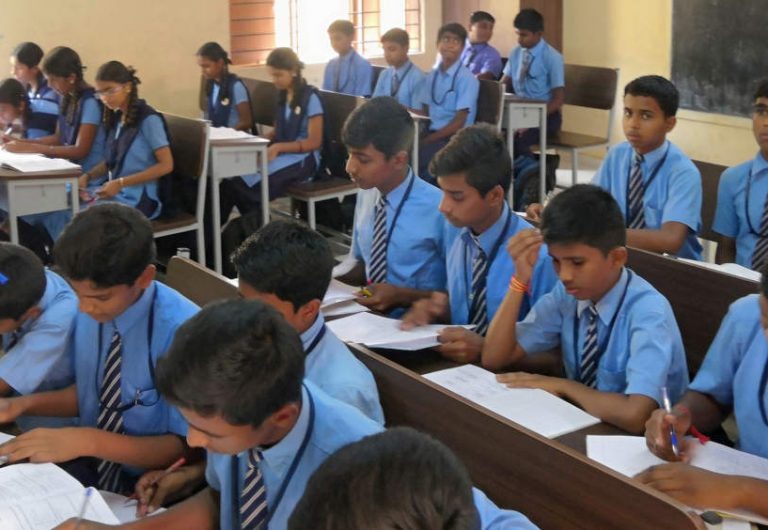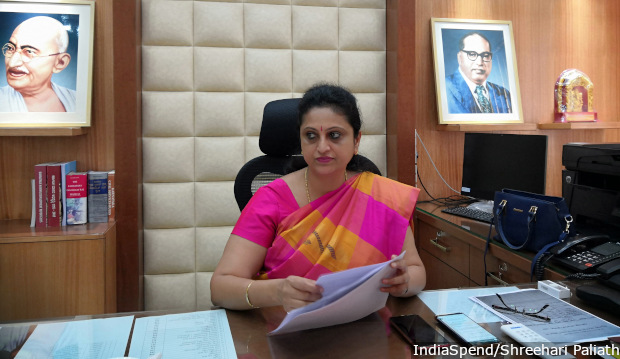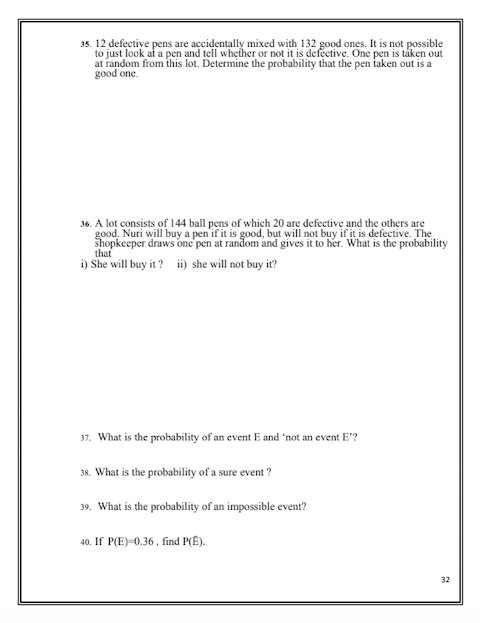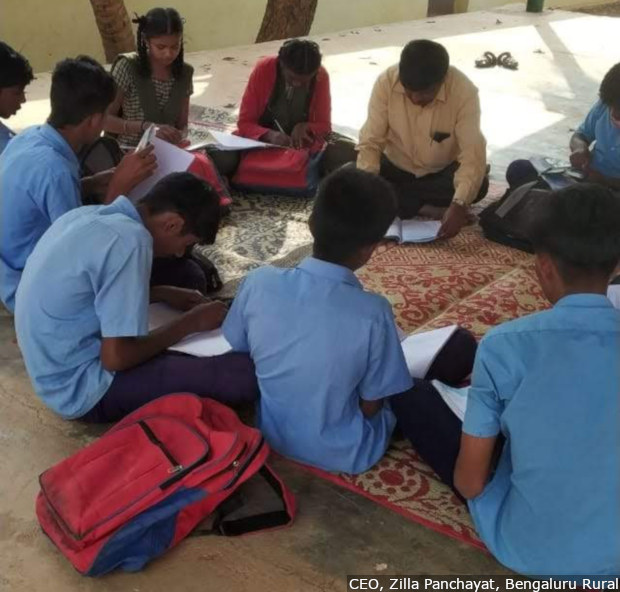Bengaluru: “I want to become an engineer. That’s why I have opted for science,” said 16-year-old Nitin Kumar as he adjusted an orange band around his wrist, gently pulling down the full sleeve of his blue-checked shirt. His father, Muniappa N, a ragi and vegetable farmer in Devanahalli, around 40 km away from Karnataka’s capital, seemed pleased.

Bengaluru Rural district improved its ranking by 11 positions to rank third in Karnataka state in the 2018-19 secondary school examinations. Some 1,983 students who scored poorly in the mid-term examination were given additional attention and support from teachers and officials, in a project financed by the corporate social responsibility arm of the Bangalore International Airport Limited. Nearly 70% of these students passed the exam.
Nitin, who scored 83% in the 2018-19 senior school leaving certificate (SSLC, or class 10) examinations in Karnataka, is the topper among 1,983 vishesha pariganitha gumpu (VPG, or special category) students who got special coaching in mathematics, science, english and social science for the exam.
Some 1,983 students who scored poorly in the mid-term examination were given additional attention and support from teachers and officials, in a project financed by the corporate social responsibility arm of the Bangalore International Airport Limited. Nearly 70% of these students passed the exam.
Compared to its performance the previous year, the district improved its rank by 11 positions to take the third place among the 34 school districts listed for the SSLC exam in 2018-19, as per a 2019 report on the SSLC results accessed by IndiaSpend. More than 88% of all students passed, up six percentage points from 2017-18 and 15 percentage points more than the state average (73.7%). Two of the four taluks (administrative units within districts)–Devanahalli and Nelamanagala–secured the fifth and sixth positions in the state, respectively.
The district’s performance is significant as Karnataka state as a whole had the worst SSLC pass percentage among the south Indian states–73.7% to Andhra Pradesh’s 94.88%, Kerala’s 98.11%, Telangana’s 92.43% and Tamil Nadu’s 95.2%.
Many Indian children leave school without the basic skills required in adult life, the Annual Status of Education Report (ASER) 2018 showed, as IndiaSpend reported on January 15, 2019. Class 10 students performed the worst in mathematics in the 2018 National Achievement Survey conducted by the National Council of Educational Research and Training.
A special category
The project aimed to improve the performance of students who had scored less than 40% in the mid-term examinations held in September 2018. It succeeded to a large extent–70% of VPG students passed, with 30% (584) securing first class (60%-70% marks) and 31% (618) obtaining second class (50-59%).
For the five months between the mid-term and SSLC exams, the project provided VPG students with intensive coaching, as we said, in four subjects–math, science, English and social science–in free-of-cost weekend classes held at centres set up especially for the purpose. The curriculum was custom-made, and the best teachers were deployed. The students were also given transport service and food. “The objective was not to just help students pass, but allow them to learn to the best of their capability,” said R Latha, Chief Executive Officer (CEO) of Bengaluru Rural district, led the initiative.
“I think that any initiative that helps students who are falling behind in their learning path is a good one,” Sreekanth Sreedharan from the Bengaluru district institute of the Azim Premji Foundation, a philanthropy funding education initiatives in rural areas, told IndiaSpend. “In this case around 2,000 such students were identified and given support in their studies. Such initiatives should be extended to all such students, not only in Class 10, but also from Classes 1 to 5 too.”
A month after Latha took charge as CEO in March 2018, the SSLC results for 2017-18 were announced. The district was ranked 14, down five places from the previous year. The then district minister, Krishna Byre Gowda, expressed his concern about the district’s performance during a review meeting and “left it to me to decide on a strategy”, Latha told IndiaSpend.

Nitin Kumar, Keerthana S, Rakshita M and Nethra K were students in the special coaching initiative of Bengaluru Rural district and obtained first class in the secondary school examinations in Karnataka. Scoring 83%, Nitin topped among the students who were part of the initiative.
An “informal committee” which included the CEO, an education consultant brought in to monitor the initiative, the chief accounts officer, chief planning officer, deputy director of public instruction and an education officer, decided to focus on students who had received less than 40% in the mid-term exams. “We included even those students who failed one subject in VPG,” said Latha. Nitin was one among them.
The committee felt various factors such as “unsystematic way of teaching, lack of professional touch from teachers, shortage of staff in some school[s] and surplus of staff in some other[s], lack of individual attention to slow learners, lack of feedback to students to improve their performance” were responsible for the low percentage, noted the report.
By October 2018, VPG students from different schools in a cluster were accommodated in a nodal centre under the charge of the headmaster or headmistress (HM). Each class in a centre had up to 50 students. “We ensured that a school with the best infrastructure in the cluster was chosen as a nodal centre,” said Latha. In all, there were 42 classrooms in 33 nodal centres.
Source: CEO, Zilla Panchayat, Bengaluru Rural
A team consisting of the “best teachers” in the district, identified with the help of education department officials, created a VPG syllabus. The respective subject teachers shortlisted the topics. Time tables were allotted and teachers at the nodal centres were assigned topics to cover each Saturday.
“We had orientation for HMs and teachers. We wanted to take them into confidence,” R Nagarajaiah, educational consultant and a part of the core committee, told IndiaSpend. “During the HMs’ orientation we clarified that their cooperation, goodwill, and leadership was necessary.”
“Although social science was introduced only by December we conducted a two-day orientation for teachers,” Bhasker R N, a social science teacher at the government high school in Bashettihalli, who was part of the committee that designed the syllabus, told IndiaSpend. “There is a lot of study material, but we had to decide on what and how to teach in a short period of time for the VPG group.”
Though selecting students was an important aspect, creating a syllabus to suit the need and the small window of five months between October and February was priority.
“A group of math teachers created a syllabus that contained 40% of the entire syllabus,” Swamy H R, a math teacher with 15 years of experience who was a part of the team, told IndiaSpend. “Last year the teachers faced a problem because the state government introduced CBSE [Central Board of Secondary Education] syllabus. This was the first batch and we did not know the pattern of the question paper.”
Classes were held every Saturday, and transportation and food was provided to the students using financial assistance of about Rs 31 lakh ($45,000) from the Bangalore International Airport Limited.
The nodal centres were supervised closely by the HMs, who reported to Latha. “I used to check weekly and expect HMs to tell me the status,” she said.

R Latha, CEO of Bengaluru Rural district, led the vishesha pariganitha gumpu initiative. The district stood third in the 2018-19 secondary school examination in Karnataka state, up 11 positions from the previous year.
First preparatory results inadequate
The results of the first preparatory exams in December were underwhelming. While Latha was expecting around 90% of the VPG students to pass, only 70% did. A part of the issue was the change in syllabus, she was told.
All math teachers in the district were summoned to analyse the first preparatory exam papers of all 1,983 students. “We wanted a wider opinion since math is seen as a difficult subject, generally, and had the potential to affect the final results,” said Latha.
After discussion it was decided that a workbook be created. Five of the most experienced math teachers were exempted from other responsibilities. “We created a workbook with 66 questions so that a student did not feel intimidated by the whole syllabus. It was 25% of the syllabus,” said Swamy, the math teacher and one of those who helped create the workbook. Questions in the workbook were based on construction and drawing, and were the most probable questions based on the teachers’ experience.
“Our focus was on ensuring basic topics like diagrams, theorem and classifications were taught and rehearsed thoroughly to the students,” added Rohini Hegde, a science teacher with over a decade of experience.

A page from the math workbook created for Bengaluru Rural district’s special category students. You can access the workbook here.
Source: CEO, Zilla Panchayat, Bengaluru Rural
Later, the use of the workbook was extended to all students in the district, Latha said, adding, “[W]e wanted to ensure that VPG students worked on it for certain. Around 44 marks [worth of questions] came from this workbook in the final exam.”
In smaller groups, students found the confidence to ask questions and clear their doubts, Nitin told IndiaSpend. “My aim was to score more than 90%. Now my sister who will appear for her SSLC this year says that she will get more than I did,” he said.

The teachers in four subjects–Math, English, Science, and Social Science–created a syllabus to suit the needs of the VPG initiative. 70% of the VPG students passed with 30% securing first class.
“The classes made it easier for me to clear my doubts and it was refreshing to meet new teachers, and make new friends,” said Rakshita M, another VPG student who got 79% and wants to work in a bank after graduating in commerce. Her father, Muniraju K M, who studied up to class 6 and is a labourer, said he was keen that his daughter continues her studies. “I think it is a good initiative for the children and should be continued,” he added.
Happy Home Schools
After three preparatory exams, 20% of the students were still failing, having received fewer than 28 marks. In consultation with Nagarajaiah, the education consultant, an initiative called ‘Happy Home Schools’ was started, which would teach a small group of up to 20 students at each school. There would be no teacher migration as classes would be taught by regular teachers.
“It is based on [Johann] Pestalozzi’s educational philosophy to help children learn in their own style,” said Nagarajaiah, explaining why students would sit on a mat on the floor with the teachers. “Each student was expected to repeat a particular topic being taught, which would then be repeated by the larger group.” They were called A1 group and a syllabus was quickly formulated as they had only 10 days before the exams were to begin.
Children were not branded as academically good or bad. “There are slow learners. We cannot expect everyone to learn at the same pace,” said Nagrajaiah.

Happy Home School was developed to help students who secured less than 28% in the third preparatory exams. It was developed by R Nagarajaiah, an educational consultant, using Johann Pestalozzi’s philosophy.
Students including Nethra K and Keerthana S benefited.
Keerthana is the first to pass SSLC in her family. While her mother has studied till class 7, her father is not educated, and both work as cement mortar workers. Her brother is a driver who dropped out of school after class 9.
“We sat around our teachers. The group was smaller than our VPG classes which helped me more,” she told IndiaSpend.
Nethra K, who had failed most of her subjects in the last preparatory, scored 67% after attending Happy Home School. Her mother, Gayathri, who works in a canteen, was glad that the initiative had borne fruit.
“Initially we did not think some of the students would pass. But the results were good,” said Roopa, an English teacher in Channahalli involved with the project. “Children were initially reluctant about VPG classes fearing that they would be called ‘dull’ students.”
Going forward: Formal and streamlined process
Government schools often have to accommodate students let go of by private schools for performing poorly (so that private schools’ performance in the SSLC is not affected), officials and teachers told IndiaSpend.
At the same time, enrolment in government schools is decreasing, overall, leading to a “very segmented and stratified education being provided to vast numbers of children by the private sector”, Sreedharan said. Old infrastructure and teacher shortages in some pockets are also big challenges.
While the effort has yielded results, the challenge is to continue the momentum next year. The initiative had to be micromanaged by the CEO, and coordination took regular updates on six WhatsApp groups.
“We have some wonderful teachers and officials which allowed us to do well,” said Latha. “But we need to formalise and streamline the process. I do not want it to end when I get transferred and move to a different district. It should continue and not require any individual’s presence.”
Individual-driven programmes lose steam very easily and we have seen this time and again, said Sreedharan, suggesting that the new method should be formalised and incorporated into the system. “[A]nd the well-structured education bureaucracy can help this scale across the state,” he said, adding that respective district CEOs can helm the project.
Sreedharan also warns that initiatives that prepare students to perform well in standardized assessments do not necessarily enhance students’ learning. “Nevertheless, given that performance in such high stakes assessments is one of the key measures of performance training students to take such assessments will be of use to them as they move on from school to higher education,” he added.
(Paliath is an analyst with IndiaSpend.)
